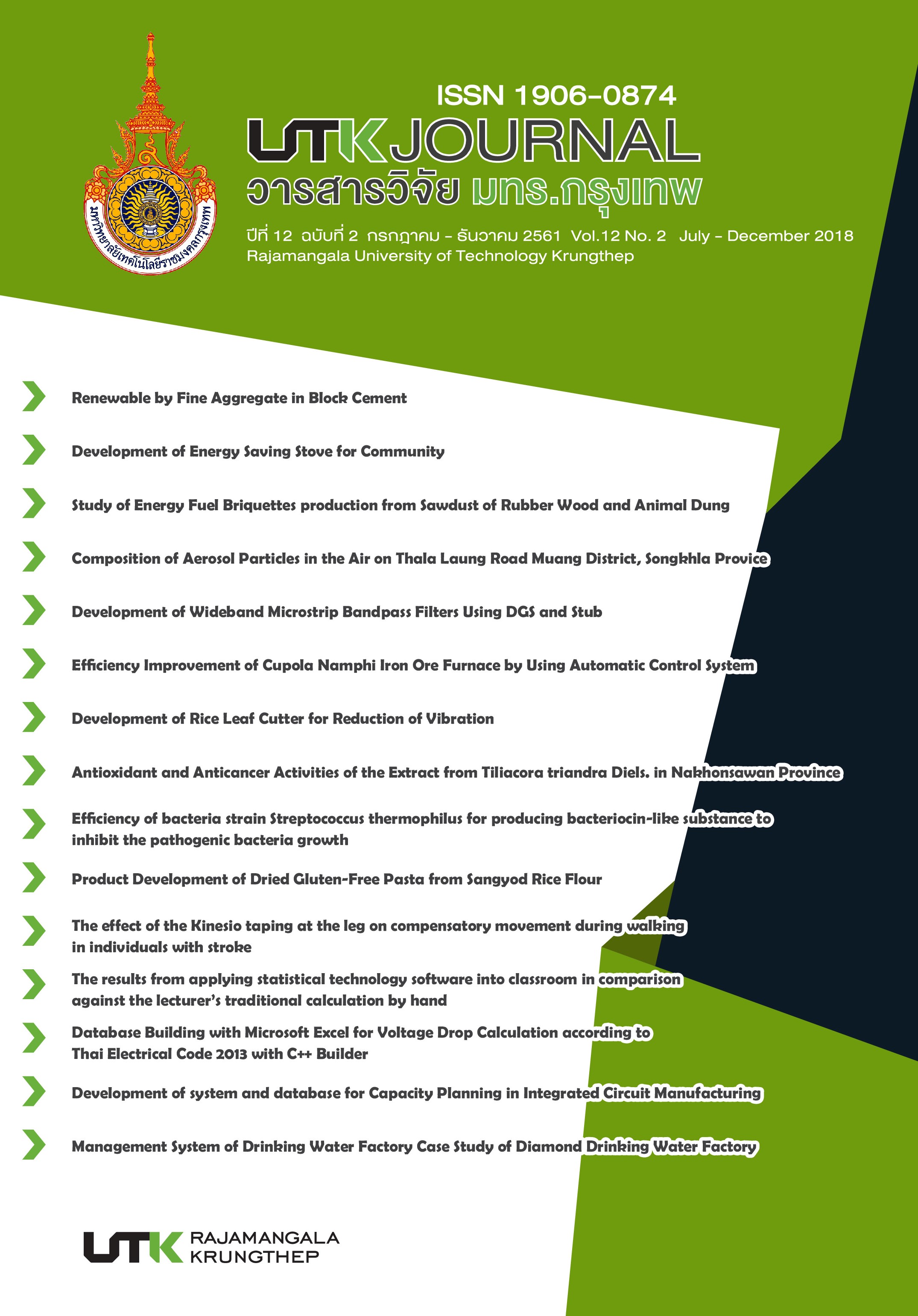Efficiency of bacteria strain Streptococcus thermophilus for producing bacteriocin-like substance to inhibit the pathogenic bacteria growth
Keywords:
Bacteriocin, Lactic acid bacteria, Streptococcus thermophilus, Staphylococcus aureus, Salmonella typhimuriumAbstract
Bacteriocin is synthesized from microorganisms, especially lactic acid bacteria. This substance can inhibit some foodbone pathogenic bacteria in human such as Salmonella typhimurium and Staphylococcus aureus. Thus, this research was aims to estimate the ability of lactic acid bacteria strain S. thermophilus found in commercial fermented milk product to construct bacteriocin-like substance for inhibiting pathogenic bacteria growth. Fermented milk produced with S. thermophilus was cultured the bacteria with deMan Rogosa Sharp (MRS) medium. Pure culture was established its growth and bacteriocin-like substance using MRS broth and UHT milk. The activity of this substance to inhibit pathogenic bacteria S. typhimurium and S. aureus was measured by agar well diffusion method. The results stated that S. thermophilus cultured with MRS broth higher grew (log 10.0 cfu/ml) than UHT milk (log 9.0 cfu/ml) at 24 hours after incubation. On the other hand, pH value was rapidly decreased as high acid pH 4.0 when S. thermophilus was cultured with UHT milk for 24 hours after incubation. Bacteriocin-like substance produced by S. thermophilus in UHT milk (2 hours) was rapidly detected more than MRS broth (10 hours). Average activity of this substance to inhibit S. aureus was higher than S. typhimurium by showing the highest activity as 200 AU/ml.
References
[2] อัจฉรา ดลวิทยาคุณ, จักรกฤษณ์ เคลือบวัง. การออกแบบรายการอาหารแลกเปลี่ยนสําหรับโรคเบาหวานโดยใช้เทคนิคการค้นหาแบบท้องถิ่นดัดแปร. วารสารวิจัย มทร. กรุงเทพ 2017; 11 (1):1-7.
[3] Perez RH., Zendo T., Sonomoto K. Novel bacteriocins from lactic acid bacteria (LAB): various structures and applications. Microb Cell Fact 2014; 13:1-13.
[4] Jack RW., Tagg JR., Ray B. Bacteriocins of gram-positive bacteria. Microbiol Rev 1995; 59(2):171-200.
[5] Ivanova I., Miteva V., Stefanova TS., Pantev A., Budakov I., Danova S., Moncheva P., Nikolova I., Dousset X., Boyaval P. Characterization of a bacteriocin produced by Steptococcus thermophilus 81. Int J Food Microbiol 1998; 42:147-158.
[6] Choi MH., Park YH. Selective control of Lactobacilli in kimchi with nisin. Lett Appl Microbiol 1998; 30: 173-177.
[7] Davies EA., Milne CF., Bevis HE., Potter RW., Harris JM., Williams GC., Thomas LV., Delves-Broughton J. Effective use of nisin to control lactic acid bacterial spoilage in vacuum packed bologna-type sausage. J Food Prot 1999; 62: 1004-1010.
[8] Jimenez LH., Guillouard I., Guedon E., Gautier C., Boudebbouze S., Hols P., Monnet V., Rul F., Maguin E. Physiology of Streptococcus thermophilus during the late stage of milk fermentation with special regard to sulfur amino acid metabolism. Proteomics 2008; 8: 4273-4286.
[9] Rossi F., Marzotto M., Cremonese S., Rizzotti L., Torriani S. Diversity of Streptococcus thermophilus in bacteriocin production; inhibitory spectrum and occurrence of thermophilin genes. Food Microbiol 2013; 35:27-33.
[10] Gutiérre D., Delgado S., Vázquez-Sánchez D., Martínez B., Cabo ML., Rodríguez A., Herrera JJ., García P. Incidence of Staphylococcus aureus and analysis of associated bacterial communities on food industry surfaces. Appl Environ Microbiol 2012; 78 (24):8547-8554.
[11] Hennekinne JA., Buyser ML., Dragacci S. Staphylococcus aureus and its food poisoning toxins: characterization and outbreak investigation. FEMS Microbiol Rev 2012; 36:815-836.
[12] Jørgensen HJ., Mork T., Caugant DA., Kearns A., Rørvik LM. Genetic variation among Staphylococcus aureus strains from Norwegian bulk milk. Appl Environ Microbiol 2005; 71:8352-8361.
[13] Balaban N., Rasooly A. Staphylococcal enterotoxins. Int J Food Microbiol 2000; 61:1-10.
[14] Park YK., Bearson B., Bang SH., Bang IS., Foster JW. Internal pH crisis, Iysine decarboxylase and acid tolerance response of Salmonella typhimurium. Mol Microbiol 1996; 20:605-611.
[15] Baik HS., Bearson S., Dendar S., Foster JW. The acid tolerance response of Salmonella typhimurium provides protection against organic acids. Microbiol 1996; 142:3195-3200.
[16] Batdorj B., Dalgalarrondo M., Choiset Y., Pedroche J., Metro F., Prevost H., Chobert JM., Haertle T. Purification and characterization of two bacteriocins produced by lactic acid bacteria isolated from Mongolian airag. J Appl Microbiol 2006; 101:837-848.
[17] Sturino JM., Klaenhammer TR. Bacteriophage defense systems and strategies for lactic acid bacteria. Adv Appl Microbiol 2004; 56:331-78.
[18] Hardie JM., Whiley RA. Recent developments in streptococcal taxonomy: their relation to infections. Rev Med Microbiol 1994; 5:151-162.
[19] Fonseca F., Marin M., Morris GJ. Stabilization of frozen Lactobacillus delbrueckii subsp. bulgaricus in glycerol suspensions: freezing kinetics and storage temperature effects. Appl Environ Microbiol 2006; 72(10): 6474-6482.
[20] Lu WW., Wang Y., Wang T., Kong J. The global regulator CodY in Streptococcus thermophilus controls the metabolic network for escalating growth in the milk environment. Appl Environ Microbiol 2015; 81:2349-2358.
[21] Kolars JC., Levittt MD., Aouji M., Savaiano DA. Yogurt: an autodigesting source of lactose. N Engl J Med 1984; 310: 1-3.
[22] Prudêncio CV., Santos MT., Vanetti MCD. Strategies for the use of bacteriocins in gram-negative bacteria: relevance in food microbiology. J Food Sci Technol 2015; 52(9):5408-5417.
[23] Somkuti GA., Renye JA. Effect of a BlpC-based quorum sensing induction peptide on bacteriocin production in Streptococcus thermophilus. J Food Res 2015; 4:88-96.
24] Chinachoti N., Matsusaki H., Sonomoto K., Ishizaki A. Utilization of xylose as an alternative carbon source for nisin Z production by Lactococcus lactis IO-1. J Fac Agr Kyushu U 1997; 42:171-181.
[25] Simova ED., Beshkova DM., Dimitrov ZP., Simov ZI. In vitro and in situ bacteriocin activity of lactic acid bacteria from Bulgarian dairy products and methods for making of Lactobacillus protective fermented milks with bacteriocin inhibitory substance. Bulg J Agric Sc 2008; 14:28-42.
[26] Beshkova D., Simova E., Frengova G., Simov Z. Production of flavor compounds by yogurt starter cultures. J Ind Microbiol Biotechnol 1998; 20: 180-186.
Downloads
Published
Issue
Section
License
กองบรรณาธิการวารสารวิชาการ มหาวิทยาลัยเทคโนโลยีราชมงคลกรุงเทพ มีความยินดีที่จะรับบทความจากอาจารย์ นักวิจัย นักวิชาการทั้งภายในและภายนอกมหาวิทยาลัย ในสาขาวิชาวิทยาศาสตร์และเทคโนโลยี ได้แก่ สาขาวิชาวิทยาศาสตร์ วิศวกรรมศาสตร์ และสาขาอื่นๆ ที่เกี่ยวข้อง รวมถึงสาขาต่างๆ ที่มีการบูรณาการข้ามศาสตร์ที่เกี่ยวข้องวิทยาศาสตร์และเทคโนโลยี ที่เขียนเป็นภาษาไทยหรือภาษาอังกฤษ ซึ่งผลงานวิชาการที่ส่งมาขอตีพิมพ์ต้องไม่เคยเผยแพร่ในสิ่งพิมพ์อื่นใดมาก่อน และต้องไม่อยู่ในระหว่างการพิจารณาของวารสารอื่น
การละเมิดลิขสิทธิ์ถือเป็นความรับผิดชอบของผู้ส่งบทความโดยตรง บทความที่ได้รับการตีพิมพ์ต้องผ่านการพิจารณากลั่นกรองคุณภาพจากผู้ทรงคุณวุฒิและได้รับความเห็นชอบจากกองบรรณาธิการ
ข้อความที่ปรากฏอยู่ในแต่ละบทความที่ตีพิมพ์ในวารสารวิชาการเล่มนี้ เป็นความคิดเห็นส่วนตัวของผู้เขียนแต่ละท่าน ไม่เกี่ยวข้องกับมหาวิทยาลัยเทคโนโลยีราชมงคลกรุงเทพแต่อย่างใด ความรับผิดชอบด้านเนื้อหาและการตรวจร่างบทความแต่ละบทความเป็นของผู้เขียนแต่ละท่าน หากมีความผิดพลาดใดๆ ผู้เขียนแต่ละท่านจะต้องรับผิดชอบบทความของตนเองแต่ผู้เดียว
กองบรรณาธิการขอสงวนสิทธิ์มิให้นำเนื้อหา หรือข้อคิดเห็นใดๆ ของบทความในวารสารวิชาการ มหาวิทยาลัยเทคโนโลยีราชมงคลกรุงเทพ ไปเผยแพร่ก่อนได้รับอนุญาตจากกองบรรณาธิการ อย่างเป็นลายลักษณ์อักษร ผลงานที่ได้รับการตีพิมพ์ถือเป็นลิขสิทธิ์ของวารสาร





